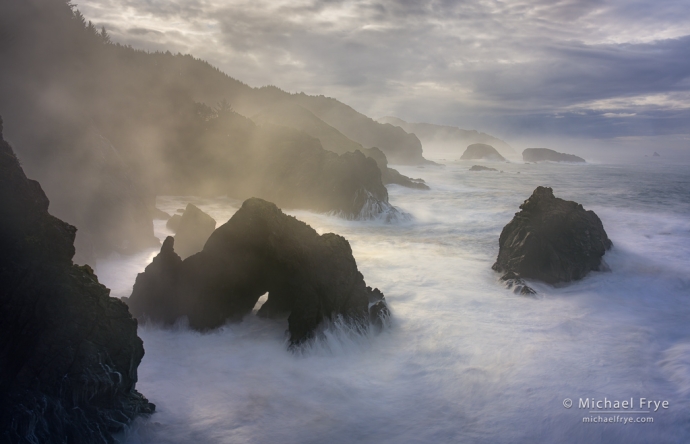
Sunlight breaking through clouds and fog, Oregon Coast. During our workshop we waited out a brief-but-heavy rain shower by sheltering underneath a dense tree canopy. After we emerged clouds blocked the sun for awhile, but eventually sunlight broke through and backlit the wave-generated mist for a few beautiful minutes. 28mm, 3 seconds at f/11, ISO 100, ND filter.
Sometimes I’m out with my camera on a clear, sunny day, and a passerby says, “What a beautiful day for photography!” I just smile and agree; there’s no point in discussing the finer points of landscape photography with a passing stranger.
And of course you can make good photographs on clear, sunny days. Those conditions are perfect for many subjects and scenes. But landscapes are usually more interesting and photogenic with clouds, fog, mist, snow, or rain – and the light that weather helps create, like sunbeams, rainbows, dappled light, colorful sunsets, and so on.
But if you’re looking to photograph that kind of weather, you have to be prepared for the side effects. Rainbows come with rain. Snow is cold, and wet, and makes driving difficult. You sometimes have to endure discomfort to catch those magic moments. But that’s something I embrace. If I get wet or cold, well, that’s just part of being out in nature. Those moments make the experience richer. They make life richer. They bring me closer to nature, and mentally and spiritually bring me closer to the subjects I’m trying to photograph. And I hope that makes my photographs deeper and more authentic.
Of course weather can be more than uncomfortable – it can be hazardous. There’s a difference between feeling cold and getting hypothermia. It’s important to know the difference between weather that could make you uncomfortable and weather that could be dangerous. It’s not worth risking your life for a photograph.
Our trip last month to the Oregon Coast was full of interesting weather, with storm following storm. We even encountered the “bomb cyclone” that brought hurricane force winds to some of that region (definitely something to ride out safely indoors). Those storms brought some big waves, as I’ve shown in a couple of recent posts (here and here), and also generated beautiful light at times. We sometimes got wet and cold, but we avoided situations that could be truly hazardous, and were rewarded with some wonderful moments. It was all really, really fun.
This small portfolio contains some of my favorite images from our Oregon trip that I haven’t posted before. These photos don’t have big waves, but do include some of the beautiful light and weather we encountered.
— Michael Frye
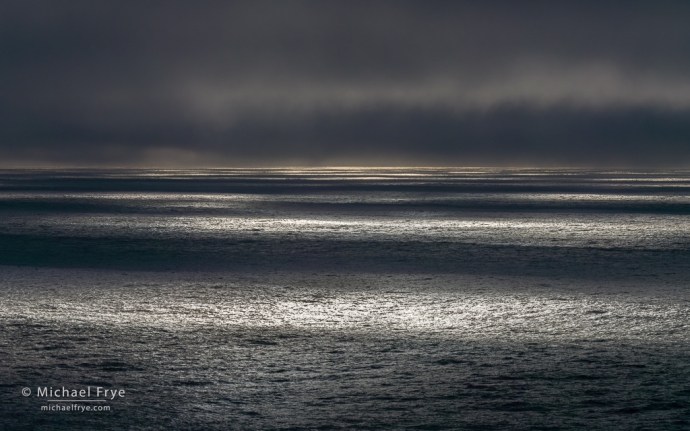
Sunlight on the Pacific Ocean, Oregon Coast. I made this photograph while scouting and photographing with my brother Peter before the workshop. We saw this beautiful dappled light on the water and rushed out to a bluff to capture it. 244mm, 1/1500 sec. at f/16, ISO 100.
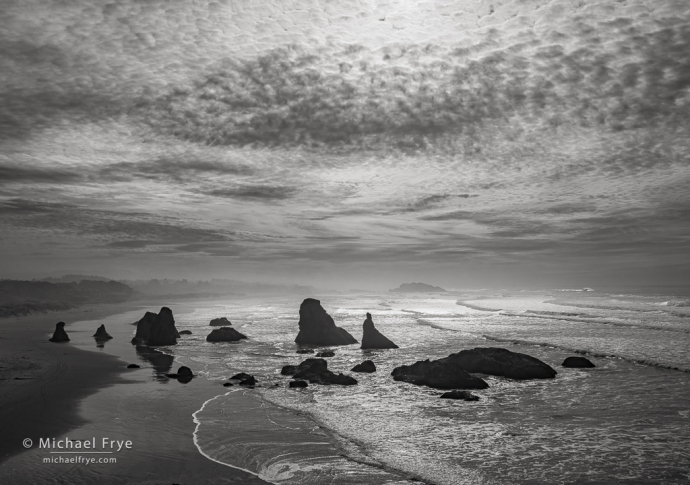
Clouds, sunlight, and sea stacks, Oregon Coast. This was the middle of the day: 12:30 p.m. But the sun never gets very high in November at this latitude, and the light breaking through the clouds and shining on the water was beautiful. 30mm, 1/1500 sec. at f/11, ISO 100.
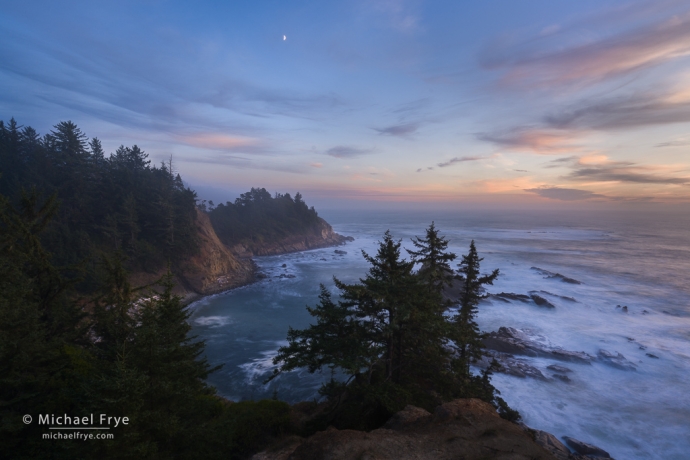
Moon at sunset, Oregon Coast. Also made before our workshop, at sunset, with a half-full moon above a classic, rocky, tree-covered Oregon coastline. 20mm, 6 seconds at f/16, ISO 100, ND filter.
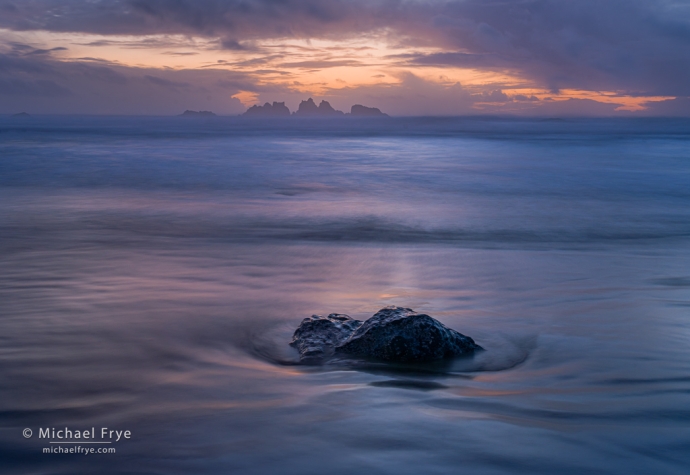
Rocks and ocean at sunset, Oregon Coast. It started raining around sunset, which seemed like a good time to pack up. But I noticed some clear skies to the west, and told our group that it might be worth sticking around. Eventually, well after sunset, those clear patches of sky took on a nice, orange glow. 40mm, 10 seconds at f/16, ISO 200 (ND filter).
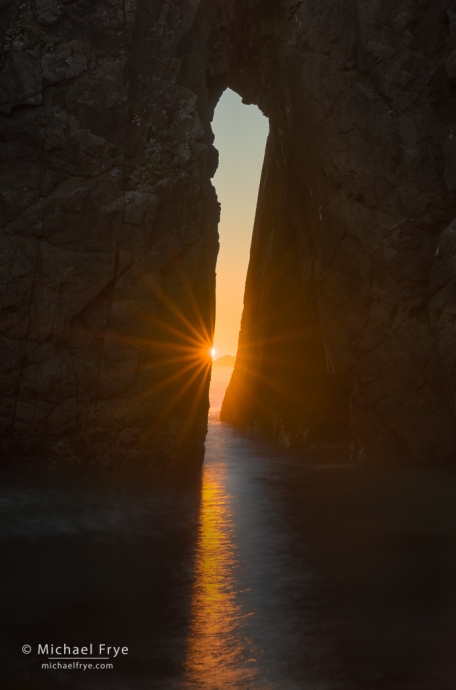
Sun setting through a natural bridge, Oregon Coast. This was a clear, sunny evening – just what you want for this scene. 66mm, 3 bracketed exposures, two stops apart, blended with Lightroom’s HDR Merge, shutter speeds ranging from 1/2 sec. to 8 seconds, f/16, ISO 100, ND filter.
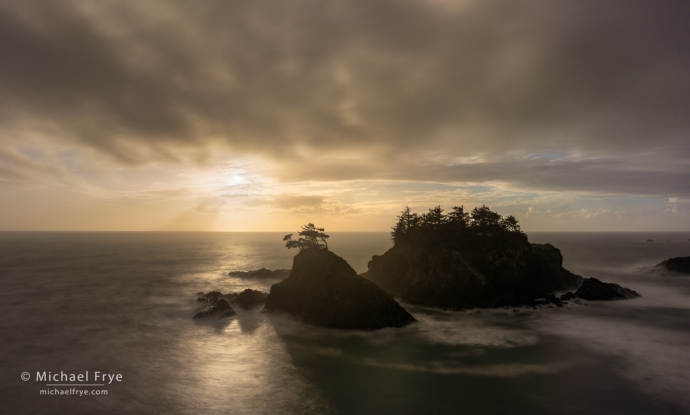
Sun setting along the Oregon Coast. We endured a bit of rain at this spot as well, but we could see a gap in the clouds to the west, and eventually the dun dipped into that gap and lit the clouds and water. 20mm. I bracketed five exposures, two stops apart, with shutter speeds ranging from 1/15 sec. to 15 seconds (at f/16, ISO 100, ND filter). I blended three of those exposures by hand in Photoshop to get detail in the clouds near the sun, as well as in the dark rocks.
Related Posts: Giving Thanks; Storms and Waves Along the Oregon Coast; Riding the Waves
Michael Frye is a professional photographer specializing in landscapes and nature. He lives near Yosemite National Park in California, but travels extensively to photograph natural landscapes in the American West and throughout the world.
Michael uses light, weather, and design to make photographs that capture the mood of the landscape, and convey the beauty, power, and mystery of nature. His work has received numerous awards, including the North American Nature Photography Association’s 2023 award for Fine Art in Nature Photography. Michael’s photographs have appeared in publications around the world, and he’s the author and/or principal photographer of several books, including Digital Landscape Photography: In the Footsteps of Ansel Adams and the Great Masters, and The Photographer’s Guide to Yosemite.
Michael loves to share his knowledge of photography through articles, books, workshops, online courses, and his blog. He’s taught over 200 workshops focused on landscape photography, night photography, digital image processing, and printing.

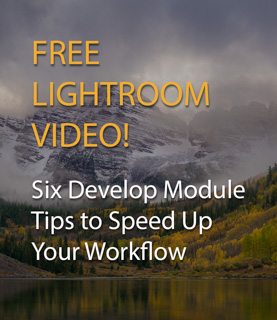





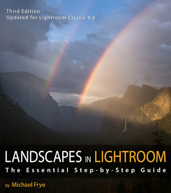
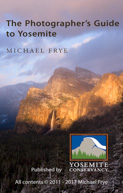
Michael: I really appreciate your inclusion of the focal length on your images… it helps convey the scale and perspective of the scene.
Glad you find that helpful Glenn. But I’d also recommend that you try to figure out the approximate focal length without looking at the caption; that kind of training will help you figure out the field of view in photographs that don’t include the focal length, and help you to see more like the camera sees:
https://www.michaelfrye.com/2017/12/10/guess-focal-length/
Hi Michael,
I’m really enjoying this series from the Oregon coast since I have visited there & recognize several of the sea stacks! 🙂
You mention using ND filters in most of the images in this post but you don’t list a strength. Does that mean you are using a variable ND filter or a favorite single strength? How do you decide what strength to use? Is it mostly trial and error?
Thanks for any clarification.
Kathy
Thanks Kathy!
I don’t use a variable ND filter, which is essential two polarizing filters attached together, because while you’re adjusting the strength of the filter you’re also changing the polarizing effects, and I want to keep neutral-density and polarizing effects separate.
I don’t include the strength of the ND filter in the captions because I don’t remember it! That’s not something that’s included in the EXIF data. I could probably guess, but it would just be a guess.
Deciding what strength filter to use can be a bit challenging. There are some apps that will help, but I find using an app for that purpose to be rather slow and cumbersome. It’s quicker to calculate in your head, if you can. For example, lets’ say there’s no filter attached, and the right shutter speed for the current amount of light is 1/15 sec. at my lowest ISO (say 100) and smallest aperture I’m willing to use (usually f/16). Then let’s say I want a shutter speed of around 4 seconds. How many stops between 1/15 sec. and 4 seconds? Six.
I calculate that way sometimes, but more often I just take an educated guess. I have 4, 7, 10, and 16-stop ND filters. In that example I’d probably be able to guess that my 7-stop filter would be about right. To confirm, I can just hold the filter up in front of the lens, then adjust the shutter speed to get the right exposure, and see what shutter speed I end up with.
Thank you, Michael. Judging whether making a photograph is worth the personal risk is always something to keep in mind! I often have to remind myself to watch where I’m putting my feet instead of only admiring the view. I especially love the first and last images above.
Thanks Rob! It’s always a good idea to watch where you’re going. 🙂 But it’s true that photographers sometimes are looking at potential compositions and not paying attention to where they’re walking.
I live an hour from the Oregon coast, and have loved it my entire life. Even in just a short stretch of the coast you can find innumerable sites for amazing photographs. There are so many unique features that unless you’re a local you’re gonna need a guidebook!
It’s great that you live so close John – it’s a great area.
Wonderful to take a little trip to the Oregon coast through the scenes you captured. The photograph of the sea stacks — just sublime.
Thanks so much Sally! And I hope you and Mark get a chance to visit in person sometime.